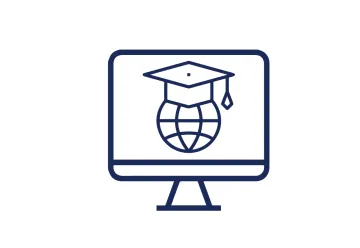Remote Study Strategies
Image

Remote learning can be challenging for those who prefer the in-person experience. However, with the correct tools, resources and strategies you can be successful.
Reading for Content
Resist the typical habits of online reading
- Why: Reading online/digital materials can be more challenging that reading from a book. You may be used to skimming through different social media posts quickly on a computer or phone. You need to adjust to be able focus and read your digital materials thoroughly.
- How: Skim differently. Also, make sure you have set aside time to focus on reading. Use the Pomodoro Method, or block other websites while you are trying to read. The apps section has a few tools that will help you stay on task
Sometimes you can “skim” your readings
- Why: You may be assigned a difficult amount of reading by your instructors, particularly if you read it word for word from beginning to end. BUT, you still need to read and know the materials.
- How: Skimming is not just skipping around or quickly reading through something (like you might do on social media). Skimming is a strategy, where you read selectively to make sure you are getting as much out of the reading as you can (quickly). You can do this by reading abstracts/summaries, the introduction, headings, and the beginning and end of each paragraph. Look at graphs, pictures and other things that are highlighted in the work.
What is the purpose of the reading?
- Why: If you know why the reading was assigned and what you should learn from it, it will be easier to make sure you are on track.
- How: Determine why the reading was assigned, does the syllabus have a heading that can tell you more about the purpose? What expectations does your instructor have for courses discussions? Is the reading related to a later assignment or is it for a test? When taking notes on the materials consider the purpose, for discussions overall concepts may be most important to note. When reading for tests, taking notes on specifics (dates, data) make be most helpful.
Reading for Content Tips from UNC
Strategies for Studying in STEM
From Stanford Remote Study Strategies
Do the 15-minute brain builder
- Why this works: The harder your brain has to work and struggle to come up with the answer without looking at the notes, the more durable your learning will be.
- How to do it: For the first problem you do in every problem set, start the timer for 5–15 minutes. Work on the problem for the entire time without reviewing notes. Jot down any questions as you go: the hows, whys, and what ifs. Afterwards, get every question answered from notes, other students, SI, or Tas.
Bonus points: work the problems you’re uncomfortable with.
Ask “Why did I do it?”
- Why this works: If you know why you took the steps you did, you’ll more easily create an effective strategy when your knowledge is tested with more complex problems.
- How to do it: After finishing a problem, for each step you took, jot down what you did and why you did it. You’ll benefit even if you only have time to do this for just one problem in the problem set.
Link problems to problems
- Why this works: The problems you will see on the test will likely be complex combinations of problems you’ve already solved. Getting used to seeing similarities and differences will help you think creatively about the harder test problems.
- How to do it: For one of the problems in every problem set, look for one other problem you’ve encountered that is similar but also different, perhaps from another problem set. Ask yourself, “How are they alike? Why are they different? Why are they in a different order?”
Practice Exams
- Why: Practice exams can help you identify growth areas and how to concentrate when studying in the future.
- How: Create some questions regarding concepts in your course, or sample problems. With your accountability partner, quiz each other on possible test questions. Participate in the THINK TANK’s Math Exam Prep.

